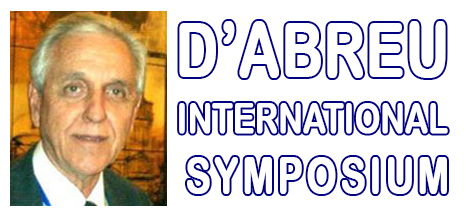List of Accepted Abstracts As of 16/12/2025: (Alphabetical Order)
Summit Plenaries
D'Abreu International Symposium (4th Intl. Symp. on Advanced Sustainable Iron and Steel Making)
Dubois International Symposium (Intl Sympo. on Sustainable Complex Metallic Systems)
Øye International Symposium (Intl Symp. on Sustainable Ionic Liquid and Aluminum Extraction and Processing)
Santilli International Symposium (Intl. Sympo. on Sustainable Mathematics Applications)
Starkey International Symposium (3rd Intl. Symp. on Sustainable Mineral Processing: Principles, Technologies and Industrial Practice)
Yagi International Symposium (2nd Intl. Symp. on Sustainable Metals & Alloys Processing)
Yang International Symposium (3rd Intl. symp. on Multiscale Material Mechanics and Multiphysics and Sustainable Applications)
2nd Intl. Symp. on Advanced Materials and Technologies for
Sustainable Energy and the Environment(AMTSEE)
2nd Intl. Symp. on Multifunctional and Smart Materials, Systems and Structures for Sustainability (MSMSSS)
3rd Intl. Symp. on Sustainable Secondary Battery Manufacturing and Recycling
3rd Intl. Symp. on Sustainable Base-metal Bio-extraction
3rd Intl. Symp. on Sustainable Cement Production
Intl. Symp. World Forum on Sustainable Coal Combustion and Processing
3rd Intl. Symp. on Sustainable Surface and Interface Engineering: Coatings for Extreme Environments
4th Intl. Symp. on Composite, Ceramic and Nano Materials Processing, Characterization and Applications
3rd Intl. Symp. on Sustainable Energy Production: Gas/Oil/Shale; Coal; Nuclear; Waste/Bioprocessing and renewables: wind/waves
5th Intl. Symp. on Environmental, Health, Policy, Legal, Management and Social Issues Related to Metals, Materials and Mineral Processing
3rd Intl. Symp. on Sustainable Production of Ferro-alloys
3rd Intl. Symp. on Sustainable Mining Operations
4th Intl. Symp. on Sustainable Molten Salt and Ionic Liquid Processing
3rd Intl. Symp. on Synthesis and Properties of Nanomaterials for Future Energy Demands
4th Intl. Symp. on Sustainable Non-ferrous Smelting and Hydro/Electrochemical Processing
2nd Intl. Symp. on Physics of Surfaces and Interfaces, from Fundamentals to
Sustainable Applications
4th Intl. Symp. on Quasi-crystals, Metallic Alloys, Composites, Ceramics and Nano Materials
3rd Intl. Symp. on Rare Earth and Platinum Group Metals: Managing and Processing
4th Intl. Symp. on Sustainable Materials Recycling Processes and Products
Intl. Symp. on Rotary Kiln Operations for Sustainable Products
INTL. SYMP. ON ROTARY KILN OPERATIONS FOR SUSTAINABLE PRODUCTS
Productivity Increase Of Industrial Rotary Kilns That Produce Magnesite Through A New Oxygen Enrichment Technology
S.
Imeri1 ;F.
Kongoli2 ;E.
Obrien3 ;
1MIM-GOLESH, Prishtina, Kosovo; 2FLOGEN TECHNOLOGIES INC., Mont-Royal, Canada; 3FLOGEN TECHNOLOGIES INC, Wilmington, United States;
Type of Paper: Regular
Id Paper: 141
Topic: 40In this cooperation project, a new oxygen enrichment technology was applied to the rotary kiln used by MIM Golesh Company to produce magnesite. This new technology improved considerably the kiln operation by increasing production capacity, decreasing the production cost and fuel consumption, as well as minimizing environmental pollution.
This paper gives the details of this technology improvement along with a description of its advantages as well as the gains in productivity, cost and environment aspects. Keywords: Rotary Kiln; Operations; Burner; Oxygen; Technology; Efficiency;
[Thermotechnics (Combustion Engineering)]
Research And Development Of Hydrometallurgical Processing Stage In Copper Industry Wastes’ Recycling Technology With Tin Recovery Into Tin Concentrate
P.
Kozlov1 ;
1CHELYABINSK ZINC PLANT, Chelyabinsk, Russian Federation;
Type of Paper: Regular
Id Paper: 216
Topic: 40Formation of skulls is one of the main disadvantages of the processes, carried out in rotary kilns (productivity decrease, process chemistry violation).
Analysis of skull formation process reveals the main causes of their growth:
-chemical composition of charge mixture (containing slag-forming compounds – CaO, SiO2, FeO);
-kiln rotation speed;
-feed material quantity;
-temperature conditions;
-grain size composition of charge mixture.
Setting operating conditions of rotary kiln in accordance with charge material composition makes possible to avoid skull formation.
At the same time, it is necessary to make the skull-formation in the kiln as a means of the furnace refractory protection from chemical and thermal “corrosion”.
It is possible to solve the problem of the furnace operation without any skulls and refractory time facing more than 12 months by rotary kiln operating in variable silica ratio mode:
- Period 1, silicate unit (C/S) – 0.4 – 0.6 (skull is not formed). Duration is 2-4 days. Skull is removed if the furnace operation is more than 4 days;
- Period 2, silicate unit (C/S) – 1.4 – 1.6 (skull is formed). Duration is 1 day. Skull can be increased if the furnace operation is more than a day.
Provision of operation mode requires the variable silicate module:
- installation of the thermal imager, controlling the furnace body temperature, which allows to estimate the skull thickness;
- repeating the furnace operation with the silicate module 1.4 – 1.6.
Keywords: Waelz process, skull, silica ratio, charge, lining, temperature gradient.
Research and development of technogenic wastes recycling with recovery of Zn, Pb&Sn
P.
Kozlov1 ;Y.
Reshetnikov2 ;
1CHELYABINSK ZINC PLANT, Chelyabinsk, Russian Federation; 2PJSC CHELYABINSK ZINC PLANT, Chelyabinsk, Russian Federation;
Type of Paper: Regular
Id Paper: 362
Topic: 40PJSC Chelyabinsk Zinc Plant processes the dust of copper-smelting industry. Copper plant dust processing differs from EAF-dust processing by charge preparation. There is no need to separate tin from lead, so the finished product is lead concentrate.<br />The main detail of the technology is the introduction of two-stage Waelz process. Waelz process 1 for the whole separation of volatile (Zn, Pb, Sn) and non-volatile components (Fe, Cu). Waelz process 2 allows Waelz-oxide purification from harmful impurities (Cl, F, As) and separation of tin from the lead. The new technology has expanded resource base of non-ferrous and ferrous metallurgy and improved the environmental situation in the regions. <br />New technologies implementation allowed:<br />- to recover more than 100 000 t of non-ferrous and ferrous metallurgy wastes that were not processed before;<br />- to get more than 10 000 t of Zn, 4 000 t of Pb and tin in the form of lead and tin concentrates out of them and also excluding these metals form the raw material for ferrous metallurgy – Zn-containing slag and non-ferrous metallurgy – copper slag. <br />Decision of ecological issues:<br />- ferrous and non-ferrous metallurgy wastes included into recycling with land areas rescue and the possibility not to pollute ground water with heavy metals;<br />- emissions reducing during Waelz-process from 10 mg/nm3 (project data) to 0.4÷0,7mg/m3;<br />- greenhouse gases emission reducing (carbon dioxide) for 2 mln m3 a year thanks to the usage of the improved construction of waste-heat boiler and stream production for zinc production technology. Keywords: Metals recycling; Operations; Technology; efficiency; emissions; waste;
« Back To Technical Program
|



